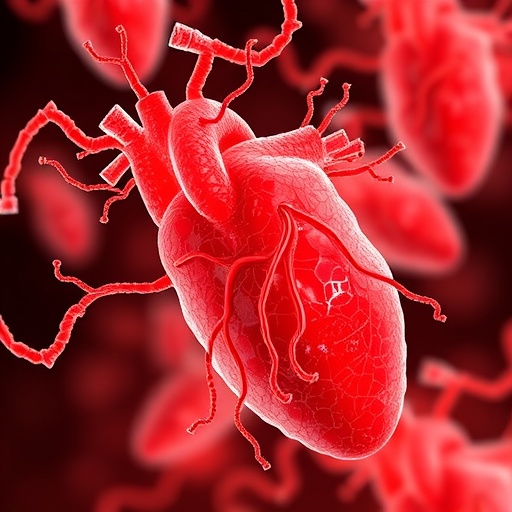In a groundbreaking study published in Nature Communications, researchers have unveiled the intricate structural characteristics of amyloid fibrils formed by atrial natriuretic peptide (ANP) extracted from patients suffering from atrial fibrillation (AF). This discovery sheds new light on the molecular mechanisms underlying cardiac arrhythmias and offers promising avenues for therapeutic interventions aimed at mitigating heart diseases associated with amyloid deposits. The research marks a significant leap forward in our understanding of the interplay between protein aggregation and cardiac dysfunction.
Atrial fibrillation, the most common sustained cardiac arrhythmia, affects millions globally and dramatically increases the risk of stroke and heart failure. While the electrophysiological irregularities intrinsic to AF have been extensively studied, the role of amyloid fibrils in the disease’s pathogenesis has remained elusive. This study meticulously characterizes amyloid aggregations derived from ANP, a hormone instrumental in cardiovascular homeostasis. By unraveling their precise structural properties, scientists aim to discern how these fibrils contribute to atrial tissue remodeling and dysfunction.
The study employed advanced cryo-electron microscopy (cryo-EM) to capture high-resolution images of ANP amyloid fibrils. This methodology allowed researchers to visualize the fibrils at near-atomic resolution, revealing unique conformational traits that distinguish these structures from other well-characterized amyloid types. Through detailed structural analysis, the team identified a distinct protofilament arrangement and polymorphism, indicating that ANP amyloid fibrils adopt a morphology that potentially interferes with normal atrial myocardium.
One of the most striking findings was the helical twist and repeating pattern of the fibrillar structures. The researchers observed that the fibrils form periodic beta-sheet-rich cores that stack in a highly ordered yet distinct manner. These features not only underpin the physical stability of the amyloid deposits but also suggest that the fibrils may exert mechanical stress on surrounding cardiac cells, possibly leading to the disrupted contractile function typical of AF.
Importantly, the research decoded amino acid interactions at the interface of the fibril cores, highlighting both hydrophobic and electrostatic forces that stabilize the assembly. These molecular interactions could serve as targets for pharmacological agents designed to inhibit fibril formation or promote their disassembly. The structural motifs described provide an essential framework for drug discovery efforts aimed at preventing atrial amyloidosis-related pathologies.
The implications of this work extend beyond fundamental biochemistry, touching on clinical cardiology and therapeutic design. While amyloid diseases have predominantly been associated with neurodegeneration, this study emphasizes the significance of protein aggregation in cardiac conditions. The identification of amyloid fibrils in atrial tissue from patients with AF accentuates the intertwined nature of protein misfolding disorders and cardiovascular health.
Moreover, the researchers compared ANP fibrils with amyloid structures implicated in other systemic amyloidoses, revealing both similarities and key differences in assembly patterns. These comparative insights suggest that, despite shared amyloidogenic pathways, tissue-specific factors modulate fibril morphology and pathology. Such nuances are critical for developing precision medicine strategies tailored to the unique amyloid populations present in different organs.
The study also addressed the biophysical parameters influencing fibril formation, including peptide concentration, pH, and ionic milieu, reflecting the complex in vivo environment of the human atrium. By replicating physiological conditions, the team was able to validate that the fibril structures identified are relevant to the human disease state rather than artifacts of in vitro experimentation, adding robustness to their conclusions.
In terms of translational potential, understanding how ANP fibrils accumulate and interact with atrial cells opens the door to biomarker development. Detecting amyloid signatures in blood or cardiac tissue could facilitate early diagnosis of amyloidogenic AF, enabling more timely and targeted therapeutic approaches. This could revolutionize patient management, helping to identify individuals at risk before irreversible atrial damage occurs.
The research underscores the multidisciplinary nature of contemporary structural biology, integrating expertise from cardiology, protein chemistry, and advanced imaging. It exemplifies how state-of-the-art technologies like cryo-EM can illuminate pathological processes at a molecular scale, bridging a critical gap between molecular mechanisms and clinical manifestations.
Furthermore, the identification of specific molecular features that differentiate ANP fibrils offers a potential blueprint for synthetic biology endeavors. Engineering peptides that can mimic or disrupt fibril assembly might become a novel therapeutic angle. Such biomimetic strategies could harness or mitigate amyloid formation, depending on intended outcomes in cardiac diseases.
The study’s comprehensive approach also included extensive computational modeling to simulate fibril dynamics and stability. These in silico analyses complemented the experimental data, providing mechanistic insights into how subtle changes in ANP sequence or structure might influence fibrillogenesis. This integrated strategy enhances confidence in the structural interpretations and broadens the scope for future experimental designs.
Given the global burden of atrial fibrillation and the limited efficacy of current treatments in altering disease progression, this research presents a promising frontier. It strengthens the argument for revisiting the role of amyloid deposits in cardiac arrhythmias and developing novel intervention strategies that go beyond electrical modulation to target underlying molecular pathologies.
In conclusion, the structural characterization of ANP amyloid fibrils from AF patients represents a paradigm shift in cardiovascular amyloid research. This work not only advances the fundamental understanding of protein aggregation in the heart but also opens new avenues for diagnosis, treatment, and possibly prevention of atrial fibrillation and related complications. As this field evolves, the fusion of structural biology with clinical cardiology holds the promise to transform how we conceptualize and combat heart disease in the future.
Subject of Research: Structural characterization of amyloid fibrils formed by atrial natriuretic peptide in patients with atrial fibrillation
Article Title: Structural characterization of atrial natriuretic peptide amyloid fibrils from patients with atrial fibrillation
Article References:
Broggini, L., Piccoli, M., Chaves-Sanjuan, A. et al. Structural characterization of atrial natriuretic peptide amyloid fibrils from patients with atrial fibrillation. Nat Commun 16, 9556 (2025). https://doi.org/10.1038/s41467-025-64618-1
Image Credits: AI Generated
Tags: advances in cardiovascular homeostasis researchamyloid fibrils in atrial fibrillationatrial natriuretic peptide researchcardiac arrhythmias and amyloidosiscryo-electron microscopy in biomedical researchelectrophysiological irregularities in atrial fibrillationimplications of amyloid deposits in heart healthmolecular mechanisms of atrial fibrillationprotein aggregation and cardiac dysfunctionstructural characteristics of amyloid aggregatestherapeutic interventions for heart diseasesunderstanding atrial tissue remodeling





